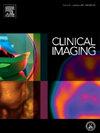4D Flow MRI derived aortic pulse wave velocity and wall shear stress in Covid-19
IF 1.5
4区 医学
Q3 RADIOLOGY, NUCLEAR MEDICINE & MEDICAL IMAGING
引用次数: 0
Abstract
Purpose
This study aimed to investigate the changes in aortic pulse wave velocity (PWV) and wall shear stress (WSS) in COVID-19 using 4D Flow MRI.
Methods
Thirty-seven COVID-19 patients and 37 healthy controls underwent thoracic cardiovascular MRI. The PWV and WSS comparisons were performed using independent t-test. Peak velocity (PV)-peak WSS correlations in patients; aortic dimension-regional WSS correlations; PWV-age correlations were reported using Pearson correlation coefficient (r) analysis.
Results
The global aortic PWV was higher in the patient group (p = 0.007). There was a positive correlation between patient age and PWV values (r = 0.650, p = 0.000). The patient ascending aorta (AAo) WSS levels were lower in the entire cohort, in the subgroup of ages between 50 and 70, and in the age/gender matched subgroup (p < 0.05 for all). Voxelwise 5 % PV was lower in the patient group (p = 0.005) and showed strong correlation with the 5 % peak WSS (r = 0.957). In the patient group there was a negative correlation between the maximal aortic dimension and AAo WSS (r = −0.398, p = 0.014) and aortic arch WSS (r = −0.388, p = 0.017).
Conclusion
The alterations to aortic stiffness in COVID-19 might be a late effect of the disease and should be confirmed in larger studies with longer follow-ups. The reasons behind the low AAo WSS levels in the COVID-19 group appears to be multifactorial and further work in larger cohorts eliminating the baseline aortic diameter and preexisting atherosclerotic risk factor differences is needed to validate our results and to establish reproducibility of the technique.
新冠肺炎患者主动脉脉波速度和壁剪应力的4D Flow MRI来源
目的应用4D Flow MRI观察新冠肺炎患者主动脉脉波速度(PWV)和壁剪切应力(WSS)的变化。方法对37例COVID-19患者和37名健康对照者行胸部心血管MRI检查。PWV和WSS比较采用独立t检验。患者的峰值流速(PV)与峰值WSS的相关性;主动脉尺寸与区域WSS的相关性;使用Pearson相关系数(r)分析报告pwv -年龄相关性。结果患者组主动脉总PWV明显高于对照组(p = 0.007)。患者年龄与PWV值呈正相关(r = 0.650, p = 0.000)。患者升主动脉(AAo) WSS水平在整个队列、年龄在50 - 70岁之间的亚组和年龄/性别匹配的亚组中均较低(p <;0.05)。在体素上,患者组5% PV较低(p = 0.005),与5%峰值WSS有很强的相关性(r = 0.957)。患者组主动脉最大径与AAo WSS (r = - 0.398, p = 0.014)、主动脉弓WSS (r = - 0.388, p = 0.017)呈负相关。结论COVID-19患者主动脉硬度的改变可能是该疾病的晚期效应,应在更大规模的随访研究中得到证实。COVID-19组AAo WSS水平低的原因似乎是多因素的,需要在更大的队列中进一步开展工作,消除基线主动脉直径和先前存在的动脉粥样硬化危险因素差异,以验证我们的结果并建立该技术的可重复性。
本文章由计算机程序翻译,如有差异,请以英文原文为准。
求助全文
约1分钟内获得全文
求助全文
来源期刊

Clinical Imaging
医学-核医学
CiteScore
4.60
自引率
0.00%
发文量
265
审稿时长
35 days
期刊介绍:
The mission of Clinical Imaging is to publish, in a timely manner, the very best radiology research from the United States and around the world with special attention to the impact of medical imaging on patient care. The journal''s publications cover all imaging modalities, radiology issues related to patients, policy and practice improvements, and clinically-oriented imaging physics and informatics. The journal is a valuable resource for practicing radiologists, radiologists-in-training and other clinicians with an interest in imaging. Papers are carefully peer-reviewed and selected by our experienced subject editors who are leading experts spanning the range of imaging sub-specialties, which include:
-Body Imaging-
Breast Imaging-
Cardiothoracic Imaging-
Imaging Physics and Informatics-
Molecular Imaging and Nuclear Medicine-
Musculoskeletal and Emergency Imaging-
Neuroradiology-
Practice, Policy & Education-
Pediatric Imaging-
Vascular and Interventional Radiology
 求助内容:
求助内容: 应助结果提醒方式:
应助结果提醒方式:


